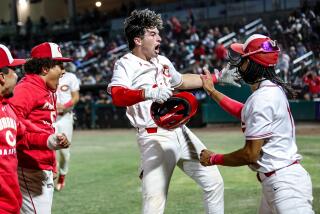Age of Aluminum : Switch From Wood Has Affected More Than Batting Technique; the Rise of Metal Has Led to the Fall of Pitchers
- Share via
Since the aluminum bat appeared on the amateur baseball scene nearly 25 years ago, it has been a certifiable measuring stick to the rise of hitting--and the decline of pitching.
The effect on hitters has been fortuitous: batters have an instrument that is lighter yet stronger than wood, whose sweet spot seems to extend from the handle to the top of the barrel.
Even though athletes are bigger and stronger today because of weight training and better nutrition, they do not have to be big and strong to hit the ball hard and far. A 26-ounce aluminum bat can be swung as fast as a 30-ounce wooden bat.
The effect on pitching has been profound.
Because the aluminum bat can turn a straight fastball into a screaming pebble, young players are being taught to throw curves and “trick” pitches when college coaches and pro scouts say they should be throwing fastballs to develop arm strength.
As a result, fewer hard throwers are emerging, and low earned-run averages might become a thing of the past. Coach Ron La Ruffa, who led Fountain Valley to Southern Section Division I championships the past two years, puts it more bluntly. “The game is getting out of balance.”
Not that the aluminum bat is the only factor. Also contributing to the decline of top-notch pitching is a de-emphasis on the game by today’s youth, who play video games daily as they once played catch. Basketball, football, soccer and tennis have siphoned off many athletes, particularly in a time when more are concentrating on one sport year-round rather than playing two or three.
“Kids are more technically advanced because the knowledge of high school and youth coaches is better. Plus the kids all go to hitting and pitching schools,” said George Horton, Cal State Fullerton associate head coach. “But instead of playing ball all the time, they’re just as apt to stay in front of TV or computer. There isn’t the physical activity of when I was a boy.
“Unless a kid does certain things at early ages, they’re not going to develop. What they gained technically, they’re losing physically.”
But there is also no denying the impact of the aluminum bat since it became available in 1973.
“It makes the below-average hitter average, the average hitter good and the good hitter excellent,” said Dave Demarest, coach of two-time defending Division III champion La Quinta.
One thing is certain, county high school batters are certainly enjoying a power-laden 1996 season.
Consider that even five years ago, in 1991, only one player--Joe Aguirre of Garden Grove--finished the season with a batting average above .500, an extremely high average at any level. Last season, seven batters hit .500 or better. According to the statistics in this week’s Prep Extra, 10 hitters are at that level. The county record for average in a season--.595, by Fullerton’s D.C. Olsen in 1990--could be in jeopardy. Olsen’s county mark of 13 home runs, also set in 1990, could also be challenged. Sonora’s Ryan Owens and Cypress’ Bobby Brito each have 10. Sonora’s Jeremy Weinberg has nine, Mater Dei’s Mike Hessman has eight. Last year, Brito and Hessman each hit 12.
Steve Leavitt, a teacher and former baseball coach at El Dorado High, as well as a part-time scout for the San Diego Padres, said it’s getting harder to find pitching prospects out of high school.
“The one thing I have seen over the years that needs to [improve] is velocity,” Leavitt said. “Instead of getting a bunch of kids that throw hard--meaning high 80s to low 90s--we get kids now that if someone hits 82-84 mph, it’s out of the ordinary.”
The pitchers who are good enough to continue playing professionally have a long and sometimes difficult readjustment period.
Jim Bennett, who pitched at Garden Grove High in 1983-84 and later in the Seattle Mariner organization, is a pitching coach for the Angels’ rookie league teams in Mesa, Ariz., and Boise, Idaho. He is one of the first professional instructors a pitcher will see after he has been selected in the June amateur draft.
“The biggest difference between high school and college players and the pros is that guys don’t understand they can throw inside to wood bats,” Bennett said. “When kids break their first bat, they are surprised.
“It’s more a mental thing than pitching mechanics. We have to start all over . . . ‘Don’t worry about hitting guys but go ahead and work the inner half of the plate.’ They have to believe they can do it. Some guys may never learn how and they don’t get out of rookie ball.”
So does something need to change in the way youngsters are being trained to pitch?
Bill Rooney, coach of the Yorba Hills team that went to the Little League World Series, and who runs the Baseball Tutor instructional school, contends kids can still learn to throw hard during their formative years of Little League and Pony League.
“Kids grow at different times. It’s all in how they develop their muscles,” Rooney said. “We have an arm training program which does not exceed three pounds of weight to prevent rotator cuff damage and strengthen muscles. We don’t let kids throw back-to-back games.”
But Rooney also said youth coaches need to review the instruction given beginning pitchers.
“The metal bat provides so much more pop; we’ve taught kids more on how to hit different and we haven’t taught them how to pitch different. When I played Little League we just threw hard and straight. Now kids have to have a variety of pitches, even in Little League. They have to be able to change speeds to mess up the hitter’s timing.”
Clyde Wright, former Angel pitcher who runs a pitching school in Anaheim, instructs more than 100 youth and high school pitchers a year.
Wright contends that, besides not developing sufficient arm strength, young pitchers are not always taught the proper ways to throw curves and other breaking pitches.
“I don’t like breaking stuff in Little League but the game has completely changed,” Wright said. “You can throw hard, and a batter can swing halfway and if he hits it, it’s gone. Pitchers are so afraid to throw over the plate now they nip at the corners and forget ‘strike one and strike two.’ You make mistakes now in Little League and high school, you get killed.
“My theory on smaller kids is they’re not learning how to properly throw pitches. I don’t want to teach 10- and 11-year-olds curves, but if the parents want it, I want to make sure they know how to do it properly. But you still have to throw hard if you want to attract the college or pro scout. They feel you can learn the other stuff, but throwing hard is what catches their eye.”
Bennett agrees that too many young players depend too much on the curveball.
“I want kids to still use the fastball for a strike, then learn to throw the fastball away and fastball in,” Bennett said. “Once they’ve accomplished that, then learn the changeup. Too many guys want to throw too many breaking pitches and they can hurt their arms early in their careers because they don’t know how to throw it correctly.”
There are some pitchers doing something right, despite the eruption in offense.
Cypress right-hander Phil Seibel threw his second no-hitter last Friday, and boasts a 9-0 mark for the leaders of the Empire League. And Fullerton’s Mike Garner (7-1), who has a mid-80s fastball that moves and a curve that breaks late, is having the best all-around statistical year of any county pitcher.
Garner has struck out 93, walked 22, allowed 33 hits and given up only three earned runs in 60 innings for a 0.35 earned-run average. He had not given up an earned run in 50 league innings until Sunny Hills’ Chris Vlopp homered against him last Friday.
Fullerton Coach Marty Berson said one reason for Garner’s success, besides talent, is the coaching staff’s insistence their pitchers reclaim the inner half of the plate.
“We gave him a different philosophy,” Berson said. “We throw up and in in the strike zone, which many schools don’t do. You can’t keep pounding the ball on the outside because kids will drive it that way. I make my pitchers throw inside enough to keep hitters honest. Aluminum bats get cheaper hits; but if you get a pitcher throwing well on both sides of the plate I don’t care what the guy is swinging.”
Other pitching coaches are demanding different things from their players.
Jeff Robinson, who pitched for the Pirates, Cubs and Angels in his major league career before joining Tip Lefebvre’s staff at Santa Margarita last year, wants his pitchers to go inside, but down rather than up.
“I don’t deviate from what I know; pitch inside but not up and in where the bat head is behind the ball,” Robinson said. “If you have good high school or college pitchers, their success is more control than power. If you keep the ball down and in, in high school you’re more effective. The outside is where the big part of the bat is.”
Bob Zamora, Capistrano Valley coach, has a program known for developing good pitchers. One of his top arms this season is Rik Currier.
“We emphasize that guys do not walk players,” Zamora said. “Throw strikes and throw low strikes; keep the infielders on their toes.
“A lot of kids aren’t developing the arm strength they had in the past. If you don’t have the fastball to throw beyond hitters, put the ball in play. We did it with wooden bats. Aluminum makes it more imperative.”
Horton said the hard thrower is still the most desired recruit among top Division I programs such as Cal State Fullerton. But strong arms alone will not be enough to equalize the advantage aluminum continues to give the batter.
“The trend over last 20 years, or since the aluminum bat, is pitching off-speed,” Horton said. “You try to miss the sweet spot of the bat--with aluminum it’s more extensive--and coaches feel the pitch swung at and missed more often is the one low and away.
“The guys that will pitch and be successful are the guys who can throw breaking balls for strikes. You still like the 90-plus guy, but it’s a tricky thing. Unless you teach them to throw something that moves, they’re not going to have success in college or high school.”
More to Read
Go beyond the scoreboard
Get the latest on L.A.'s teams in the daily Sports Report newsletter.
You may occasionally receive promotional content from the Los Angeles Times.










